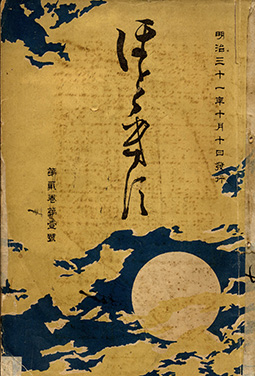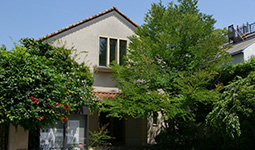October 2022
- PREVIOUS
- NEXT
Takahama Kyoshi: A Haiku Poet Who Composed Clear-Eyed Poems about Nature and the Changing of the Seasons

Takahama Kyoshi 
Cover of Kyoshi Kushu (a collection of haiku poems by Kyoshi), published in 1928, Shunjusha Publishing Company 
The cover of the October 1898 edition of Hototogisu, the first edition published with Kyoshi as editor and publisher 
The Kyoshi Memorial Museum, located in Ashiya City, Hyogo Prefecture

Takahama Kyoshi (1874–1959) looked at natural phenomena and the changing of the seasons with clear eyes, and he composed many haiku with objective descriptions while also training other haiku poets.

Takahama Kyoshi (hereinafter, “Kyoshi”) was born in 1874 in what is now Matsuyama City, Ehime Prefecture. Kyoshi began studying haiku as a junior high school student under haiku poet Masaoka Shiki* (1868–1902, hereinafter, “Shiki”), who was from the same province. That was with an introduction from classmate Kawahigashi Hekigoto (1873–1937) (hereinafter, “Hekigoto”), one of Shiki’s two greatest pupils along with Kyoshi.
It was Shiki who gave him his pen name, “Kyoshi.” At age 20, Kyoshi and Hekigoto moved to Tokyo with the help of Shiki, who was living there. Shiki seemed to know that he was approaching the end of his life due to a serious illness, and he asked Kyoshi to become his successor, having acknowledged Kyoshi’s talent as a haiku poet. But the still-young Kyoshi did not accept. However, their teacher-student relationship continued until Shiki’s death.

In 1898, Kyoshi took over all of the editing and publishing for Hototogisu, a haiku magazine established in the preceding year in cooperation with Shiki. As a result of Kyoshi working on Hototogisu, it became a general literary magazine, featuring serial novels and more along with haiku.
As editor of Hototogisu, Kyoshi began to select haiku sent in by readers, so-called senku. Kyoshi later said, “Selecting poems is itself creative work.” He said that choosing what to select, what to focus on, and how to evaluate a poem from among many haiku is related to the eye for beauty of the person selecting and is a true and fine act of creativity. To Kyoshi, selecting haiku was a creative activity just the same as composing haiku.
So, what were the characteristics of the haiku Kyoshi composed? Kobayashi Sachiyo, curator of the Kyoshi Memorial Museum, explains as follows.
“Kyoshi noted that the main viewpoints (or concepts) of his own haiku were kacho fuei (to compose poems about flowers, birds, and nature in general) and objective portrayals. “Kacho fuei” is a phrase that Kyoshi himself coined. It is an idea of haiku creation that looks honestly at and respects the various phenomena of the natural world and the changing of the four seasons, and places value on kigo, or seasonal words. Objective portrayals highlight the author’s emotions through a collection of objective expressions rather than by expressing things subjectively.”

In addition to demonstrating his abilities with haiku creation and as a poetry instructor, Kyoshi also wrote a primer on haiku and worked to train many pupils. He also worked to train female haiku poets starting in the 1910s, when there were few women composing haiku. He did so by hosting gatherings of haiku poets for women, creating a column in Hototogisu for women, and more.
In 1954, Kyoshi was the first haiku poet to be awarded the Order of Culture by the Japanese government. He died five years later in 1959 at the age of 85. Kyoshi is said to have composed more than 30,000 haiku in his lifetime. Active as a haiku poet for many years, he spent his life as a driving force in the world of haiku, connecting the late 19th century with the present day.
* See Highlighting Japan September 2022, “Masaoka Shiki: A Poet Who Brought Innovation to Haiku” https://www.gov-online.go.jp/eng/publicity/book/hlj/html/202209/202209_12_en.html
Hakubotan to
iu to iedomo
kou honoka
A white peony
We say, yet I sense
Faint pink
—Translation by Aya Nagayama and James W. Henry, III, Inabata Teiko, 100 Works of Kyoshi: Trafford Publishing, 2009
Composed in 1925 at the age of 51. Hakubotan (a white peony) is the kigo (seasonal word) for early summer. One of Kyoshi’s famous haiku. It speaks of the fact that while it is called a white peony, you can see a slight pink color if you look closely. You can feel Kyoshi’s sense of praise for nature along with an objective observation of nature in his eyes as he noticed that there were parts that were slightly pink when observing the white flower.
Tohyama ni
hi no ataritaru
kareno kana
The sun shines
On the distant mountains;
Withered field
—Translation by Aya Nagayama and James W. Henry, III, Inabata Teiko, 100 Works of Kyoshi: Trafford Publishing, 2009
Composed in 1900 at the age of 26. Kareno (withered field) is the kigo for winter. This poem speaks of a scene where the winter sun shines on a distant mountain making it bright, but cold, a withered field spread out before the viewer. Kyoshi noted that a life with strong sunshine was not bad but was bothersome, and that the life he desired was that of a quiet view with the sun shining on the tip of a distant mountain. He said, “This haiku has established the state of mind for composing my haiku.” Although this haiku was written when he was young, it is a haiku that Kyoshi wrote repeatedly in calligraphy until his last days.
Toki mono o
kaiketsu suru ya
haru o matsu
May time solve
Worries and difficulties—
Awaiting the spring
—Translation by Aya Nagayama and James W. Henry, III, Inabata Teiko, 100 Works of Kyoshi: Trafford Publishing, 2009
Composed in 1914 at the outbreak of World War I at the age of 40. Haru o matsu (awaiting spring) is the kigo for winter. Kyoshi explains this haiku, saying, “If we halfheartedly try to solve our troubles, they quickly become even more entangled. If we instead let nature take its course, things will become untangled in time. Let us quietly bear the cold winter days and wait for the warm spring days to come.” You can see Kyoshi’s view on life in this haiku.
- PREVIOUS
- NEXT

